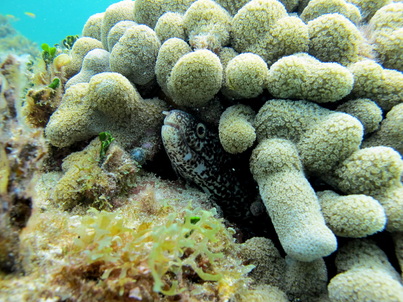 Animal, Vegetable, or Mineral? For thousands of years, people had a hard time figuring stony corals out. It was hard, but it was alive, but it was mostly stationary. Even today, many people think that coral is some kind of living rock. In fact, corals are made up of animals, vegetables, and minerals! They are animals which secrete an external calcium carbonate (mineral) skeleton and have plants living inside their cells providing them with energy! In the picture to the left, you can see our first example coral (and an eel, but we're going to ignore him for the moment). The common name for this type of coral is "Finger Coral" and you can see why--it's made up of protruding pillars that look a bit like fingers. The scientific name for this species is Porites porites. Coral skeletons take diverse forms, even in corals that are closely related. Some "branch" like a tree, some grow into circular "boulders", and some form flat plates on the seafloor. Corals also respond to local conditions and can grow accordingly--in rough water where the pillars are likely to break, Porites will grow shorter, thicker fingers. One of the reasons that this coral is a good first example is that the structure of the underlying skeleton is clear, but you can also see the polyps clearly, because Porites often keep their tentacles out during the day. See how it looks like it's covered in tiny fuzzy circles? Corals are actually large colonies of genetically identical polyps, living and building their skeleton together.  Photo Credit: FGBNMS/Schmahl Photo Credit: FGBNMS/Schmahl Here's a close up of polyps with their tentacles out. You can see that they're all connected, but also that they're individuals. The polyps live in a mat on top of the calcium carbonate skeleton they have created. Each polyp biomineralizes calcium carbonate underneath itself, which is how the coral skeleton grows. Each polyp also contains Zooxanthellae, a big word for a tiny algae. These unicellular algae live inside the cells of the coral's body, in the gastrodermis (don't worry, we'll talk about coral anatomy in a later post). These algae photosynthesize like other plants--but they turn over a lot of the energy they create to their host coral. This is what we call a symbiotic relationship: one that benefits both of the organisms involved. The corals are able to grow faster and meet their metabolic needs using the energy produced by zooxanthellae photosynthesis, while the zooxanthellae are given a safe place to live where they can receive enough light to grow and enjoy protection from predators. This allows corals to live in relatively nutrient poor water, since they can get energy not just from the particles they catch with their tentacles and eat, but from the algae inside their cells. When symbiosis breaks down, corals release their zooxanthellae in a process we call "bleaching" (it's actually the algae inside their cells that give most corals their color; seeing through the polyp to the skeleton is what makes bleached corals look white). We'll be digging deeper into coral anatomy next time!
0 Comments
Leave a Reply. |
Field Notes
Archives
July 2021
Categories |
|
Partner with us! We are always looking for new schools, scientists, and non-profit organizations to partner with. Please contact us here to start a conversation.
Hear from us! Sign up for our newsletter to hear about what is happening at Field School as well as upcoming offers and specials. |

 RSS Feed
RSS Feed